
I’m so excited to guide you on your journey towards fat loss, strength, and a healthier relationship with food. So here’s what you will learn with this blueprint about carb cycling.
How Carb Cycling can maximize fat loss:
Specific methodology to implement carb cycling into your daily regimen;
An approved foods list to make it easier for you;
Supplementation suggestions;
An example of a Carb Cycle layout and the portion control method to use with the approved foods list.
Let’s begin by discussing what carb cycling IS and what it IS NOT. Firstly, Carb Cycling is a fat loss & weight loss nutrition strategy. Notice I didn’t say DIET – the word diet carries too many negative connotations. I believe there is a specific psychology behind any nutritional regimen, and most DIETS are restrictive, unrealistic, and ultimately lead to non-compliance.
I speak from experience. As a physique athlete, I followed extremely restrictive diets to achieve the body I wanted. Though I looked great aesthetically, the truth is, I felt horrible. I had ZERO energy, felt like I was hurting my metabolism, and my strength was plummeting. The diets I followed weren’t giving me all the nutrients I needed to thrive, both for my health and my performance.
I knew there had to be a better way. A way to maximize fat loss while staying lean, and also improve strength and performance. I wanted a plan that would help me have a healthier mental relationship with food and LIVE LIFE again. This was found with carb cycling! I could even factor in 2 treat meals a week and NOT FEEL GUILTY ABOUT IT.
The Pros & Cons of Carb Cycling
I could talk about the PROS all day, but to gain your trust, I also want to share the CONS. They’re minimal, but if you’re committed to putting in the work, you’ll find that carb cycling could be the best thing for your health and fitness goals.
Here are two important components for success:
Meal Prepping and Planning: Carb cycling requires nutrient timing. You’ll need to consume certain nutrients on specific days, so having meals ready or at least knowing what you’ll be eating on high-carb days is crucial.
Whole Foods Intake: Aim for 90% whole foods in your diet. The other 10%? That’s where your “splurge” meals (treat meals) fit in, especially on carb-loading days. So, the majority of your nutrition should come from the approved foods list I’ve provided in this blueprint.
How Carb Cycling Maximizes Fat Loss
The science behind carb cycling is simple – by limiting your intake of starchy, complex carbs to specific days of the week, you allow your body to maximize fat metabolism. On high-carb days, you reload your body with the necessary glucose, insulin, and glucagon to preserve muscle mass, help protein transport, and recover from workouts efficiently.
In short:
Low Carb Days (LC) help maximise fat loss;
High Carb Days (Load) help preserve strength and muscle mass;
Example Carb Cycle Layout:
Day Carb Day Type
Mon LC
Tues LC
Wed LC
Thurs Load
Fri LC
Sat LC
Sun Load
You will need to go without starchy carbohydrates for at least 48 hours for carb cycling to be effective. If you’re starting with a heavy carb intake, try the 48-hour window first, and then transition to the 72-hour window for even better results.
Quick Tip:
If you’re carb sensitive or have any insulin-related concerns, consult your physician before starting. Also, if you feel foggy without carbs, start with the 48-hour protocol.
Goal:
So stick to this plan for 8 weeks (2 months), paired with an exercise routine. Use the accountability logs to track your progress. Whether you choose the 48-hour/2-day protocol or the 72-hour/3-day protocol, be sure to mark each day as either LC (Low Carb) or LOAD (Carb Load) to track your journey.
Thank you again for choosing this guide! I can’t wait for you to experience the results and changes that come with this new strategy. Let’s crush those goals and start this transformation together!
FITVIEW personal training



